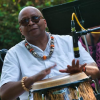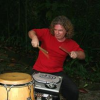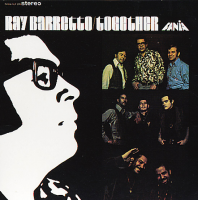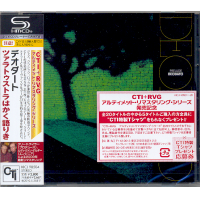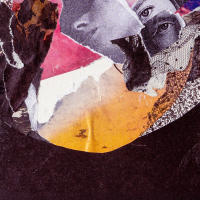Home » Jazz Musicians » Ray Barretto
Ray Barretto
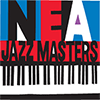
Barretto was born on 29 April 1929, in the Brooklyn borough of New York City, of Puerto Rican parents. Noted for his many years as a prominent Latin bandleader, his music career actually began as a studio performer on the conga for jazz recording sessions.
He was raised in the Latin ghettos of East Harlem and the Bronx, in an environment filled with music of Puerto Rico but with a love for the swing bands of Ellington, Basie and Goodman. He escaped the ghetto by joining the United States Army when he was 17 years old, but he did not escape the music.
Influenced by a record of Dizzy Gillespie, “Manteca”, with conguero Chano Pozo. He was hooked and he knew then that his calling was was to become a professional musician. Barretto sat in on jam sessions held at the Orlando, a GI jazz club in Munich, Germany. After military service in 1949, he returned to Harlem and taught himself how to play the drums.
Barretto’s first regular job was with Eddie Bonnemere’s Latin Jazz Combo. He then went on to play for four years with Cuban bandleader/pianist Jose Curbelo. In 1957, Barretto then replaced Mongo Santamaria in Tito Puente‘s band, with which he recorded nis first album: Dance Mania. After four years with Puente, he was one of the most sought-after percussionists in New York City’s thriving music scene. He attended jam sessions with notable artists such as Max Roach, Charlie Parker, Art Blakey and other jazz giants. He also recorded with Sonny Stitt, Lou Donaldson, Red Garland, Gene Ammons, Eddie “Lockjaw” Davis, Cannonball Adderley , Freddie Hubbard, Cal Tjader, Dizzy Gillespie, and others.
Barretto got his first job as a bandleader in 1961 when Orrin Keepnews of Riverside Records, asked him to form a charanga for a recording. Keepnews was familiar with Barretto’s jazz work and the collaboration resulted in the album Pachanga With Barretto. This was followed by the Latin jam Latino in 1962, on which Barretto was joined by Jose “Chombo” Silva on the tenor sax and Alejandro “El Negro” Vivar on the trumpet.
In 1962, Barretto released the album Charanga Moderna. The track “El Watusi” reached the Top 20 pop chart in the United States in 1963 and went gold.
His next eight albums between 1963 and 1966 thrashed around in various directions and consistently eluded commercial success. The musical merit of some of his recorded work from this period was not appreciated until years later. His fortunes changed when he signed to Fania Records in 1967. He dropped violins for an all-brass frontline and made the R&B- and jazz-flavoured Acid, which won him major popularity among Latin audiences for the first time.
Read moreTags
Que Viva La Musica

by C. Andrew Hovan
Much has been made about the making of a hybrid style involving Latin music and jazz strains that was established by Dizzy Gillespie and Chano Pozo in the late '40s. However, the ripples of those early experiments would reach far and wide for subsequent decades, even if the casual listener might have been largely unaware of such developments. One of the key figures to come from this movement would be the late conguero Ray Barretto, who has yet to be ...
Continue ReadingGene Ammons: Boss Tenor

by Matthew Aquiline
Tenor saxophonist Gene Ammons' tone can be best described using the qualities of an ideally brewed cup of joe: rounded, bold, smooth, and exhilarating after first taste. Widely regarded as an original founder of the “Chicago school of tenor sax," Ammons' nonchalant, yet indelible sound--echoing the soft, breathy tone of Lester Young--drove him to a great deal of fame within the post- World War II jazz crowds of the '50s. Ammons, famously nicknamed “Jug," had an inherent ability ...
Continue ReadingRay Barretto: Jazz

by Graham L. Flanagan
Although both of his parents were full-blooded Puerto Ricans, Ray Barretto was as American as they come. Born in Brooklyn, by the age of seven he had already resided in that borough, as well as Spanish Harlem and the Bronx. His biological lineage, combined with the place he was born and raised, gives new meaning to the concept of Latin jazz. Fania honors his legacy with a compilation featuring ten of the strongest works he recorded for the ...
Continue ReadingRay Barretto: Que Viva La Musica, Indestructible & Live at the Red Garter, Vol. 1 & 2

by Russ Musto
Ray Barretto Que Viva La Musica Fania 2006 Ray Barretto Indestructible Fania 2006 Fania All-Stars Live at the Red Garter, Vol. 1 Fania 2006 Fania All-Stars Live at the Red Garter, Vol. 2 Fania 2006
Continue Reading
Zoho Music: Latin Jazz, New York City Style

by C. Michael Bailey
Zoho Music has established itself as the pre-eminent purveyor of Latin jazz. Resurrected from the ashes of the former Khaeon label by Jochen Becker, Zoho boasts a stable of renowned and diverse musicians. Here are three of the best recordings recently released by the label.
Ray Barretto Standards Rican-ditioned Zoho Music 2006
Standards Rican-onditioned was the last recording released by New York percussionist Ray Barretto before his death in ...
Continue ReadingRemembering Ray Barretto

by AAJ Staff
By David Amram When Ray and I first met and played together in the Fall of 1955 at the Monday night sessions at the 125 club in Harlem, Ray was the only conga player and I was the only French horn player who always showed up. We used to always laugh because we were surrounded by a small army of great musicians who played what were then considered traditional jazz instruments. ...
Continue ReadingRay Barretto: Time Was - Time Is

by Russ Musto
Ray Barretto continues to refine his brand of swinging, Latin-inflected jazz with each succeeding release. On Time Was - Time Is, the venerable conguero leads a polished instrumental ensemble featuring Joe Magnarelli on trumpet and Myron Walden on alto with Robert Rodriguez at the piano and Sean Conly and Vince Cherico on bass and drums. The set kicks off with a couple of Afro-Cuban classics. Bobby Sanabria joins the group on percussion to emphasize the folkloric rhythms ...
Continue ReadingWeekly Latin Jazz Video Fix: Tito Puente, Mongo Santamaria, Candido Camero, and Ray Barretto

Source:
The Latin Jazz Corner by Chip Boaz
Percussion sits at the heart and soul of Latin Jazz, providing the music's cultural lifeline and rhythmic vitality. The use of percussion certainly sets Latin Jazz apart from straight ahead jazz, but it is so much more than a simple novelty. Embedded in each hit of the drum is a cultural legacy, associated with centuries of social development. When that deep legacy blends with the rich cultural history of the African American experience through jazz, miracles can happen. Percussionists are ...
read more
Tribute to Ray Barretto at Creole August 22 & 23

Source:
Ann Forster
Latin Jazz Legacy Series Presents TRIBUTE TO RAY BARRETTO Featuring: Steve Turre (Special Guest), Chembo Corniel, Vince Cherico, Boris Kozlov, Peter Brainin, John Di Martino Friday, August 22nd & Saturday, August 23rd Showtimes 8:00pm & 10:00pm
NEW YORK: Creole Restaurant and Music Supper Club continues to invigorate the Harlem Jazz scene with its Latin Jazz Legacy Series featuring TRIBUTE TO RAY BARRETTO Friday, August 22nd and Saturday, August 23rd, Showtimes 8:00pm and 10:00pm at Creole, 2167 ...
read more
Tribute to Ray Barretto at Creole Supper Club!

Source:
All About Jazz
Creole Restaurant and Music Supper Club 2167 Third Avenue (N.E. corner 118th St.), New York, New York 10035 - (212) 876-8838
Presents
: LATIN JAZZ LEGACY SERIES
AUGUST 2009 August 21st and 22nd at 8:00pm & 10:00pm
TRIBUTE TO RAY BARRETTO
Featuring the super-talented artists: Special Guest Steve Turre (trombone), Chembo Corniel (conga) Vince Cherico (drums), Boris Kozlov (bass), Peter Brainin (saxophones), John Di Martino (pianist, musical director) - Paying homage to the Grammy winning Latin jazz giant Ray Barretto - ...
read more
Highlights in Jazz 2008 Season Line Up

Source:
Jim Eigo, Jazz Promo Services
JACK KLEINSINGER Presents Highlights In JAZZ New York's Longest Running Jazz Concert Series Highlights In Jazz 2008 Season THURSDAY, JANUARY 3, 2008 - 8 PM Remembering Ray Barretto featuring Sonny Fortune Dave Valentin Steve Turre Bobby Sanabria Steve Kroon Arturo O'Farrill Trio Thursday, February 14, 2008 - 8 pm Highlights In Jazz 35th Anniversary ...
read more
Jack Kleinsinger's Highlights in Jazz Presents Remembering Ray Barretto Thursday, January 3rd 8PM at the Tribeca Performing Arts Center

Source:
Jim Eigo, Jazz Promo Services
THURSDAY, JANUARY 3, 2008 - 8 PM Remembering Ray Barretto featuring Sonny Fortune, Dave Valentin, Steve Turre, Bobby Sanabria, Steve Kroon and the Arturo O'Farrill Trio
All concerts will take place at the Tribeca Performing Arts Center (Borough of Manhattan Community College), 199 Chambers Street (between Greenwich and West Street). $30 General Admission / $27.50 Students Make checks payable to: Highlights in Jazz - Mail to: Highlights in Jazz, 7 Peter Cooper ...
read more
ZOHO Label to Release "Standards Rican-ditioned," Ray Barretto's Last CD Recording

Source:
All About Jazz
ZOHO Label set to release “Standards Rican-ditioned", Ray Barretto's Last CD Recording
Latin jazz indie label ZOHO Music L.L.C. announces the release of Standards Rican-ditioned, the last recording by the legendary percussionist Ray Barretto--who passed away unexpectedly on February 17, 2006, at the age of 76. The planned release date is August 14, 2006.
In the summer of 2005, Ray Barretto met with Jochen Becker from ZOHO in New York City to discuss plans for his next recording. Ray wanted ...
read more
Ray Barretto Viewing, Wed Feb 22, Riverside Chapel

Source:
All About Jazz
Ray Barretto Passed Away, Fri Feb 17, 2006 Services to be held: LOCATION: Riverside Chapel ADDRESS: 180 West 76th Street, Bet Amsterdam & 76th St. DATE: Wednesday, February 22nd, 2006 TIME: 11:00am-5:00pm and 6:00pm -10:00pm Band leader, percussionist, NEA Jazz Master & Grammy Award winner Ray Barretto will be viewed at the Riverside Memorial Chapel on Wednesday, February 22, 2006 from 11 - 5 p.m. and 6 - 10 p.m. located at 180 West ...
read more
National Endowment for the Arts mourns passing of NEA Jazz Master Ray Barretto

Source:
All About Jazz
Washington, DC - NEA Chairman Dana Gioia released the following statement upon the death of NEA Jazz Master Ray Barretto: “Ray Barretto was a pioneer, a legend, and a leader and we are proud to have added 'NEA Jazz Master' to that list of superlatives. All of us at the NEA are deeply saddened at Ray's untimely death and offer our condolences and prayers to his family. Ray Barretto will always have our respect and admiration for all that he ...
read more
Latin Jazz Drummer Ray Barretto Dies

Source:
All About Jazz
HACKENSACK, N.J. -- Ray Barretto, a Grammy-winning Latin jazz percussionist known for integrating the conga drum into jazz, died Friday, officials said. He was 76. Barretto had undergone heart bypass surgery in January and suffered from pneumonia, said George Rivera, a friend and family spokesman. He died at Hackensack University Medical Center with his wife and two sons by his bedside. “He was suffering too much, so the Lord took him," Fidel Estrada, a family friend, told The Associated Press ...
read more
Ray Barretto, Grammy wining Latin jazz percussionist, dead at 76

Source:
All About Jazz
HACKENSACK, New Jersey (AP) - Ray Barretto, the Grammy-winning Latin jazz percussionist who had recently undergone heart surgery, died Friday, hospital officials and friends said. He was 76.
George Rivera, a friend who has been serving as a family spokesman, said Barretto died with his wife and two sons by his bedside at the Hackensack University Medical Center. Barretto had undergone heart bypass surgery in January and was operated on again two weeks later after an artery burst.
“He survived ...
read more



